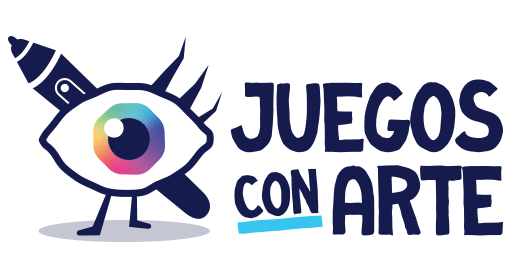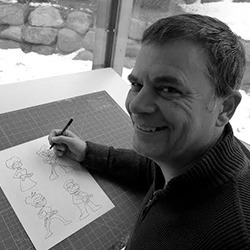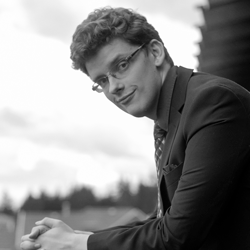
Gracias al juego de mesa Volfyirion descubrimos las ilustraciones llenas de fantasía y tecnología de Travis Anderson, artista conceptual, 3D y responsable del fantástico universo de Mysthea.
Queremos agradecer a la editorial Bumble3ee Interactive por ponernos en contacto con él para poder charlar sobre su trayectoria y la creación del deck-building Volfyirion.
ENG | Welcome Travis, thanks for working with us! For our readers who don’t know your work yet, could you tell us a little about yourself and your professional career?
My name is Travis Anderson, I am a very energetic (except on Mondays) concept artist and CG generalist. I currently work at Atomhawk and multiple triple A games for a variety of studios but also in the past have been a board game artist and CG generalist/ concept artist for TV.
I had my start in making film festival successful animated short films, graphic novels and book covers while I was in school for 3D animation. When I finally left school I found myself making art for the trading card game Dragonborne by Bushiroad and then as a lead artist for Tabula Games Mysthea project which gave me work on and off for many years.
My confidence boosted as an artist and I found my first stable art job in Metanaut as a concept artist/ 3D generalist for their various projects including various research projects by UBC and «Gadgeteer.» Those projects for UBC gave me an in to do some teaching at UBC and helping their Emerging Digital media lab mainly as a 3D general artist.
My first proper in house job as a 3D generalist/ concept artist was at FuseFx where I worked on many shows like: Snowpiercer, Shadow and Bone, The 100, Upload, Magicians, Debris, Deadly Class, The In-between, I-land, NeXt, The Main Event, Penny Dreadful, and many others that I may have forgotten. My only problem was that I wished to focus mainly on concept art rather than asset creation, matte painting and animation sometimes. Which then brought me to Atomhawk where I work on all types of games as a concept artist. The game titles of which I am not sure I can talk about yet.
ESP | Bienvenido Travis, ¡gracias por colaborar con nosotros! Para nuestros lectores que aún no conocen tu trabajo, ¿podrías contarnos un poco sobre ti y tu trayectoria profesional?
Me llamo Travis Anderson, soy un artista conceptual y generalista CG muy enérgico (excepto los lunes). Actualmente trabajo en Atomhawk y en múltiples juegos triple A para una variedad de estudios, pero también en el pasado he sido un artista de juegos de mesa y generalista de CG / artista conceptual para la televisión.
Me inicié en la realización de cortometrajes animados con éxito en festivales de cine, novelas gráficas y portadas de libros mientras estudiaba animación 3D. Cuando finalmente dejé la escuela, me encontré haciendo arte para el juego de cartas coleccionables Dragonborne de Bushiroad y luego como artista principal para el proyecto Mysthea de Tabula Games, que me dio trabajo de forma intermitente durante muchos años.
Mi confianza aumentó como artista y encontré mi primer trabajo de arte estable en Metanaut como artista conceptual / generalista 3D para sus diversos proyectos, incluyendo varios proyectos de investigación de la UBC y «Gadgeteer». Esos proyectos para la UBC me permitieron dar clases en la UBC y ayudar a su laboratorio de medios digitales emergentes, principalmente como artista general de 3D.
Mi primer trabajo como artista generalista/conceptual de 3D fue en FuseFx, donde trabajé en muchos programas como: Snowpiercer, Shadow and Bone, The 100, Upload, Magicians, Debris, Deadly Class, The In-between, I-land, NeXt, The Main Event, Penny Dreadful, y muchas otras que puedo haber olvidado. Mi único problema era que deseaba centrarme principalmente en el arte conceptual en lugar de en la creación de recursos, el matte painting y la animación en ocasiones. Lo que me llevó a Atomhawk, donde trabajo en todo tipo de juegos como artista conceptual. Los títulos de los juegos de los que no estoy seguro de poder hablar todavía.
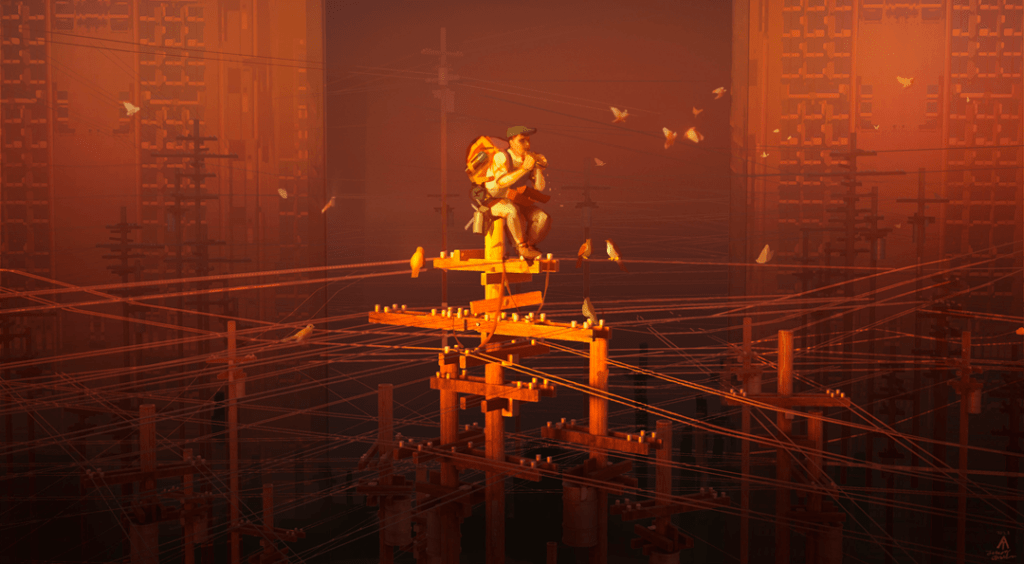
ENG | Now that we know you a bit better, which artists or references have influenced your style and way of working nowadays?
The artist I currently work with right now is a big inspiration. Shout out to Thomas Stoop, Brock Grossman, and Arif Cagatay Ugurlu. My favourite artists of all time though have to be James Gurney, Sergey Kolesov, Piotr Jablonski and Simon Stalenhag. Projects likes the game Dishonored, Bioshock and Portal are my absolute favourite.
ESP | Ahora que te conocemos un poco mejor, ¿qué artistas o referentes han influido en tu estilo y forma de trabajar actualmente?
El artista con el que trabajo actualmente es una gran inspiración. Un saludo a Thomas Stoop, Brock Grossman y Arif Cagatay Ugurlu. Pero mis artistas favoritos de todos los tiempos son James Gurney, Sergey Kolesov, Piotr Jablonski y Simon Stalenhag. Proyectos como el juego Dishonored, Bioshock y Portal son mis favoritos absolutos.
ENG | What tools/software do you use to compose your illustrations?
I use all manner of 3D tools as well as 2D. I often start pieces in VR, gravity sketch, medium, or in photoshop if I plan to go mostly 2D. Then I transfer over to Blender for texturing and lighting/rendering. There are optional steps before that stage like bringing the 3D into Zbrush or substance painter depending on the time I have. Once I export a render out of Blender its a matter of painting over it in Photoshop to bring it to final.
ESP | ¿Qué herramientas/software utilizas para componer tus ilustraciones?
Utilizo todo tipo de herramientas 3D y 2D. A menudo empiezo las piezas en VR, gravity sketch, medium, o en photoshop si planeo ir principalmente en 2D. Luego paso a Blender para texturizar e iluminar/renderizar. Hay pasos opcionales antes de esa etapa como llevar el 3D a Zbrush o substance painter dependiendo del tiempo que tenga. Una vez que exporto un render de Blender es cuestión de pintar sobre él en Photoshop para llevarlo a la versión final.
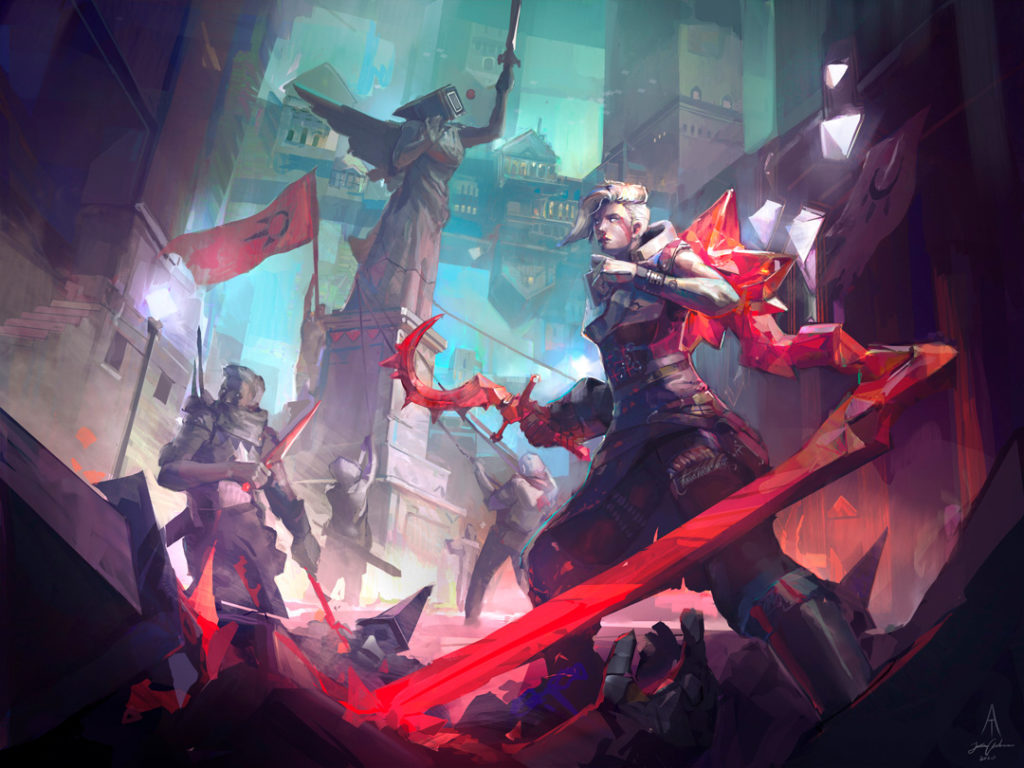
ENG | You are responsible for the art of Mysthea, a universe that mixes fantasy and technology in a unique way and that we can enjoy thanks to the publishing house Tabula Games. What references and inspiration have you used to create this fantastic world?
I was inspired by the works of the previous artists I mentioned as well as a combination of Guild Wars 2, a touch of Darksouls 3 a smidge of Dishonored, and a bit of the Ghibli movies like Spirited Away. Other than that it was a lot of looking at crystals, massive building structures, brutalism, and tribal designs.
ESP | Eres el responsable del arte de Mysthea, un universo que mezcla fantasía y tecnología de una forma única y que podemos disfrutar gracias a la editorial Tabula Games. ¿Qué referencias e inspiración has usado para crear este mundo fantástico?
Me inspiré en las obras de los artistas anteriores que he mencionado, así como una combinación de Guild Wars 2, un toque de Darksouls 3 una pizca de Dishonored, y un poco de las películas de Ghibli como Spirited Away. Por otro lado, yo estuve viendo muchos cristales, muchísimas estructuras de edificios y diseños tribales.
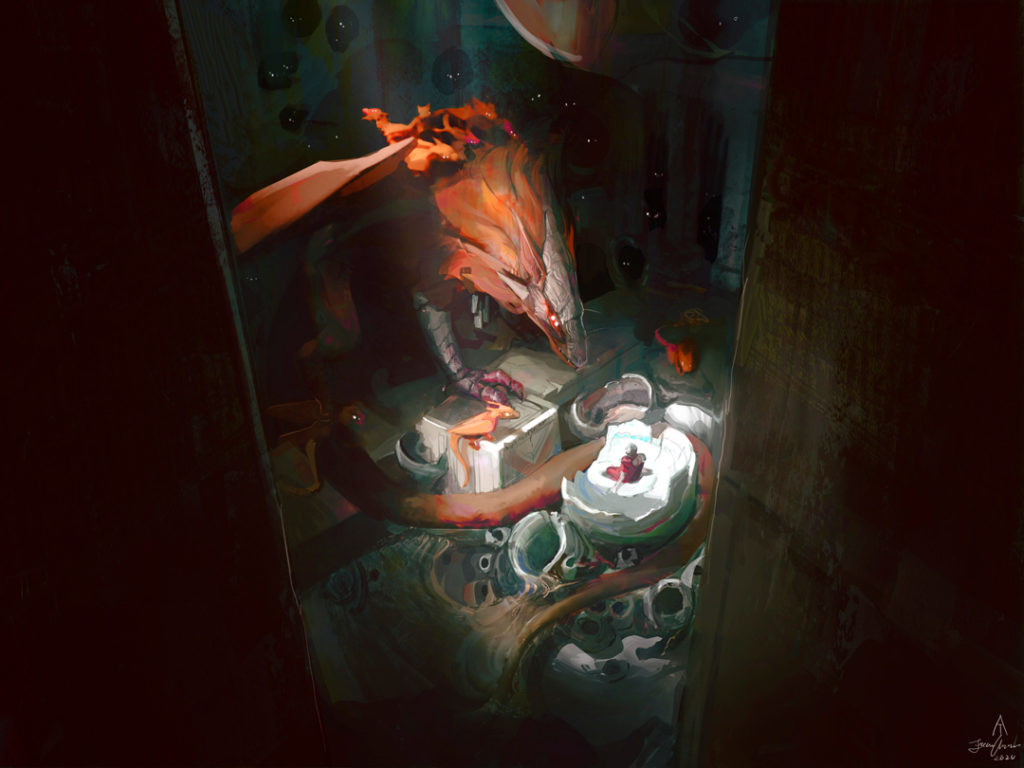
ENG | You have continued expanding the story of Mysthea to create the card game called Volfyirion, which will be available in Spanish thanks to the publisher Bumble3ee. What can you tell us about the game?
Volfyirion is a deck-building game centered around destroying your opponent’s cities via pure strength or awakening the dragon that stars in the game and sending it at your opponents. Personally, it is my favorite one out of all the board games I worked on. It is easy to pick up and set up/ a joy to play.
ESP | Has seguido ampliando la historia de Mysthea para crear el juego de cartas llamado Volfyirion, que estará disponible en español gracias a la editorial Bumble3ee. ¿Qué puedes decirnos sobre el juego?
Volfyirion es un juego de construcción de mazos centrado en la destrucción de las ciudades de tu oponente por medio de la fuerza pura o despertando al dragón que protagoniza el juego y enviándolo a tus oponentes. Personalmente, es mi favorito de todos los juegos de mesa en los que he trabajado. Es fácil de llevar y montar, un placer jugarlo.
ENG | Volfyirion is set sixty years before the events of Mysthea, how was the process of documentation and chronological adaptation for its creation?
We did make this game after Mysthea so there was some head-scratching on what that would look like. I mostly kept the technology mostly consistent while stripping away some of the characteristics of the separate guilds as I believe they formed after the fact.
ESP | Volfyirion está ambientado sesenta años antes de los acontecimientos de Mysthea, ¿cómo fue el proceso de documentación y adaptación cronológica para su creación?
Hicimos este juego después de Mysthea, por lo que hubo que pensar en cómo sería. Mantuve la tecnología en su mayor parte, pero eliminé algunas de las características de los distintos gremios, ya que creo que se formaron a posteriori.
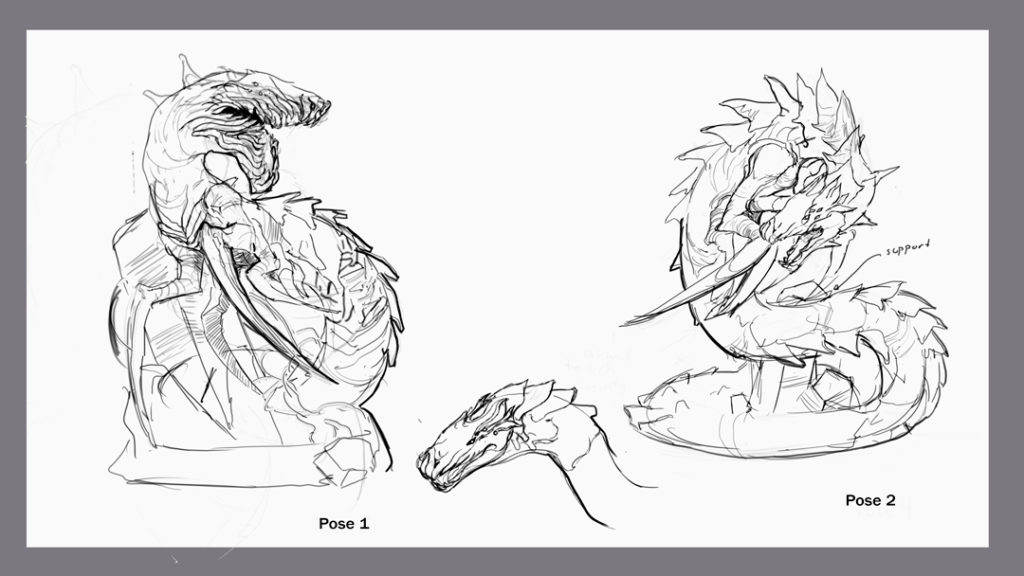

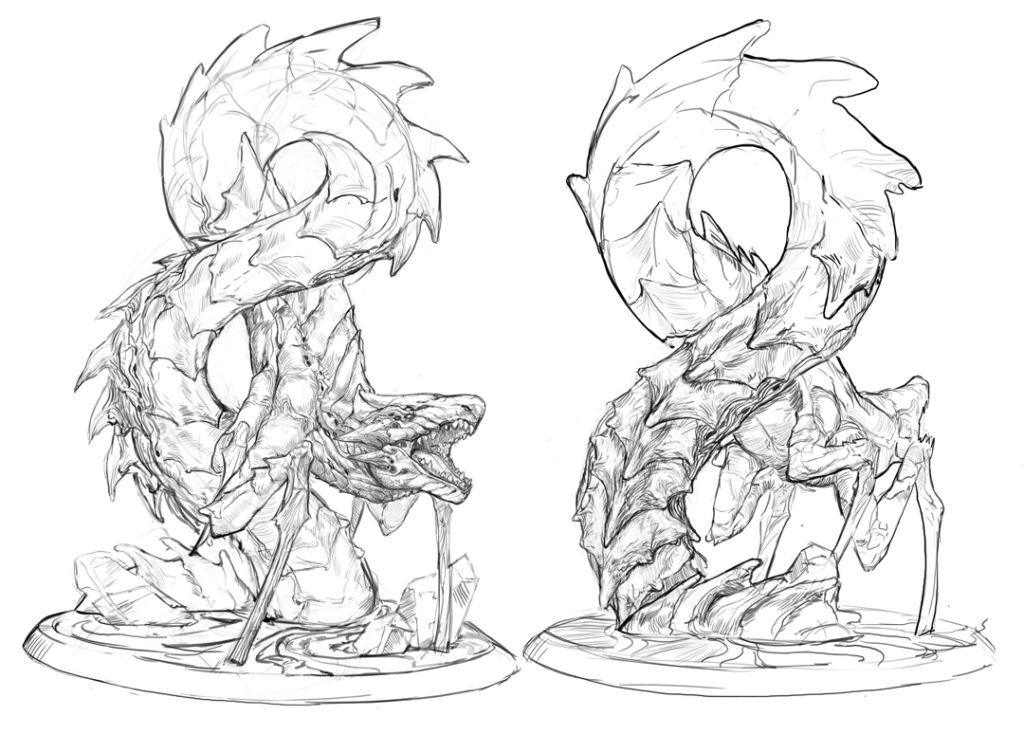
ENG | How was your creation process? Tell us about this process, from the first ideas to the final artwork.
It was a tad intense, the time window was shorter this time and I would be trying to create a card daily for Tabula. But I had learned a lot about art in that short time and was growing at a quick pace. We started by getting the dragon a bit more refined in design and created the star artwork of him then dived into the world-building in cards. Working diligently I built a narrative surrounding the details of people’s lives in this world. I asked myself questions like how do they harvest crystals, how do they trade, and what effects do these time-space crystals have on affecting the world? Keeping my themes consistent I was given prompts for the cards and tied them together to form cohesive images.
ESP | ¿Cómo fue tu proceso de creación? Cuéntanos sobre este proceso, desde las primeras ideas hasta el arte final.
Fue un poco intenso, la linea de tiempo era más corta esta vez y estaría tratando de crear una carta diaria para Tabula. Pero había aprendido mucho sobre el arte en ese corto tiempo y estaba creciendo a un ritmo rápido. Empezamos por afinar un poco más el diseño del dragón y creamos la obra de arte estrella de él, y luego nos sumergimos en la construcción del mundo en cartas. Trabajando con diligencia, construí una narrativa en torno a los detalles de la vida de la gente en este mundo. Me pregunté ¿cómo recogen los cristales, cómo comercian y qué efectos tienen estos cristales espacio-temporales en el mundo?. Manteniendo la coherencia de mis temas, me dieron indicaciones para las cartas y las uní para formar imágenes coherentes.
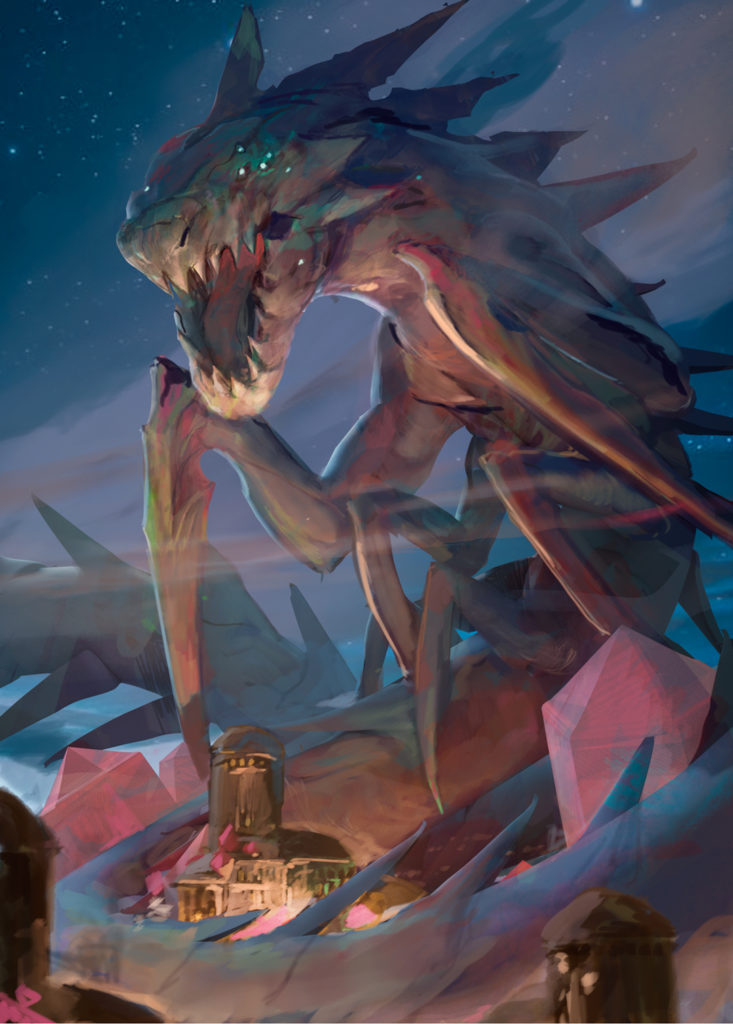
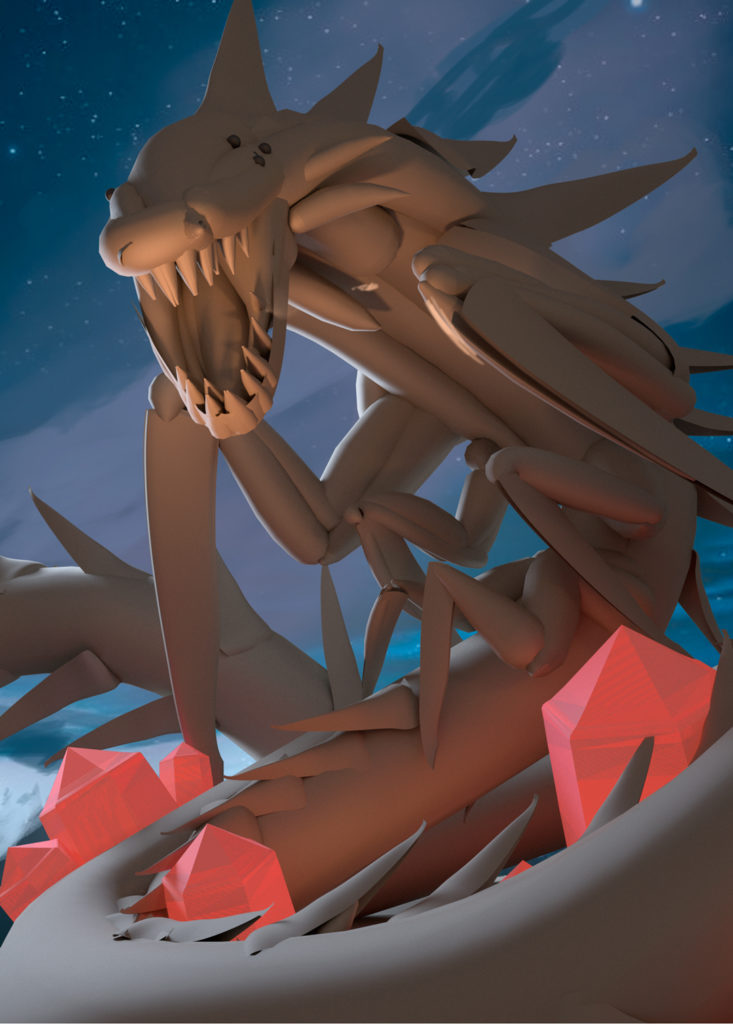
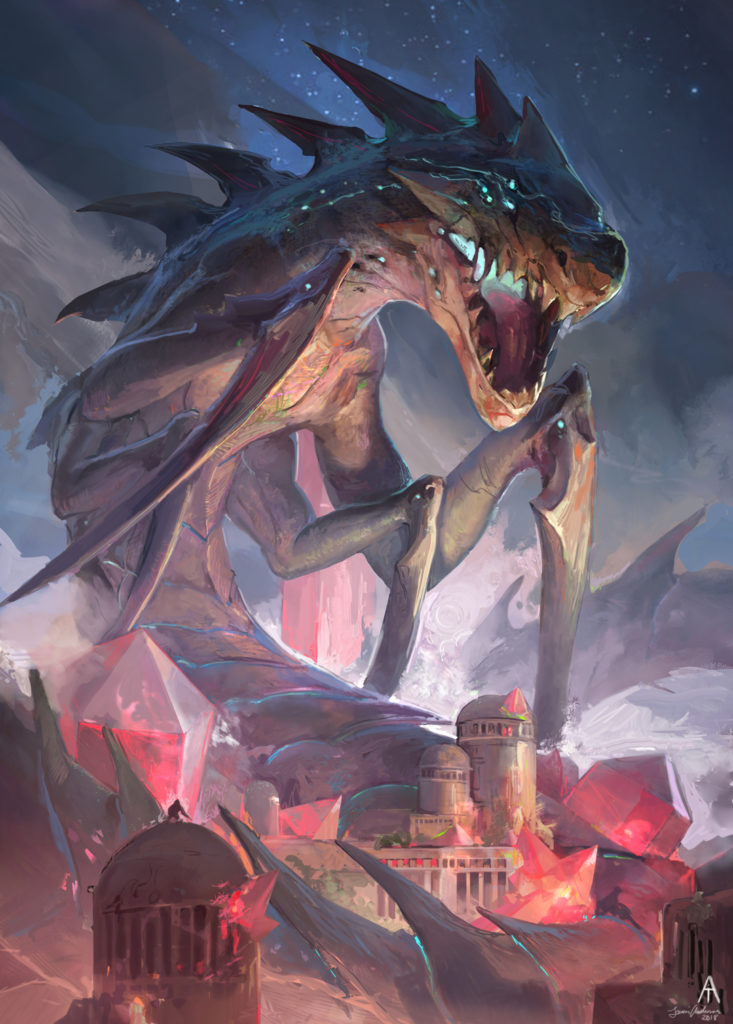
ENG | The most striking feature of this confrontation game is the figure of the fearsome Volfyirion: THE DRAGON, which you can control to attack your rival or directly try to kill him. Can you tell us what steps you followed for its creation?
Volfyirion is a creation surrounding the dragon that I just thought to put into one of the backgrounds of the guild faction of Mysthea. It was inspired by the endless serpents seen in the book series The Arrival by Shaun Tan. People were curious about it so it transformed into a beast that could be at the center of its own deck building spin-off. We did go through some iterations as I wanted to make it more frightening and alien but we settled on it being a bit more of a hydralisk-inspired, dragon hybrid with an endless body. After settling on a pose I went in and did a detailed turnaround drawing to show it from all sides which Tabula’s resident modeler took up to create. I then modeled my own quick proxy version in VR in a different pose for the key art.
ESP | Lo más llamativo de este juego de enfrentamientos es la figura del temible Volfyirion: EL DRAGÓN, al que puedes controlar para atacar a tu rival o directamente intentar acabar con él. ¿Puedes contarnos qué pasos seguiste para su creación?
Volfyirion es una creación en torno al dragón que se me ocurrió poner en uno de los fondos de la facción del gremio de Mysthea. Se inspiró en las serpientes interminables que se ven en la serie de libros Arrival, de Shaun Tan. La gente sentía curiosidad por ella, así que se transformó en una bestia que podría ser el centro de su propio spin-off de construcción de mazos. Pasamos por algunas iteraciones, ya que quería hacerla más aterradora y alienígena, pero nos decidimos por un híbrido de dragón inspirado en un Hidralisco con un cuerpo infinito. Después de decidir la postura, hice un dibujo detallado para mostrarlo desde todos los lados, que el modelador residente de Tabula se encargó de crear. Luego modelé mi propia versión proxy rápida en VR en una pose diferente para el arte clave.
ENG | During the process of creating Volfyirion, which parts were the most challenging and how did you solve them?
I think the weirdest and hardest thing was Tabula’s wish to have 3 cards make up a bigger image so it can be split apart into cards. This made creating compositions pretty difficult. I did make it happen via clustering the cards close together and doing triangular compositions but it definitely made things tough. The other thing was a rule that was set from the beginning for its people design. They had to have no facial hair and no skin pigmentation. This made the creation of characters in general and backers as characters difficult as many of them had beards. I solved this issue by being inspired by Maori people and facial tattoos.
ESP | Durante el proceso de creación de Volfyirion, ¿qué partes fueron las más desafiantes y cómo las resolviste?
Creo que lo más extraño y difícil fue el deseo de Tabula de que 3 cartas formaran una imagen más grande para poder dividirla en cartas. Esto dificultó bastante la creación de composiciones. Lo conseguí agrupando las cartas cerca unas de otras y haciendo composiciones triangulares, pero definitivamente dificultó las cosas. La otra cosa fue una regla que se estableció desde el principio para el diseño de las personas. Tenían que carecer de vello facial y de pigmentación en la piel. Esto dificultó la creación de los personajes en general y de los backers como personajes, ya que muchos de ellos tenían barba. Resolví esta cuestión inspirándome en el pueblo maorí y en los tatuajes faciales.
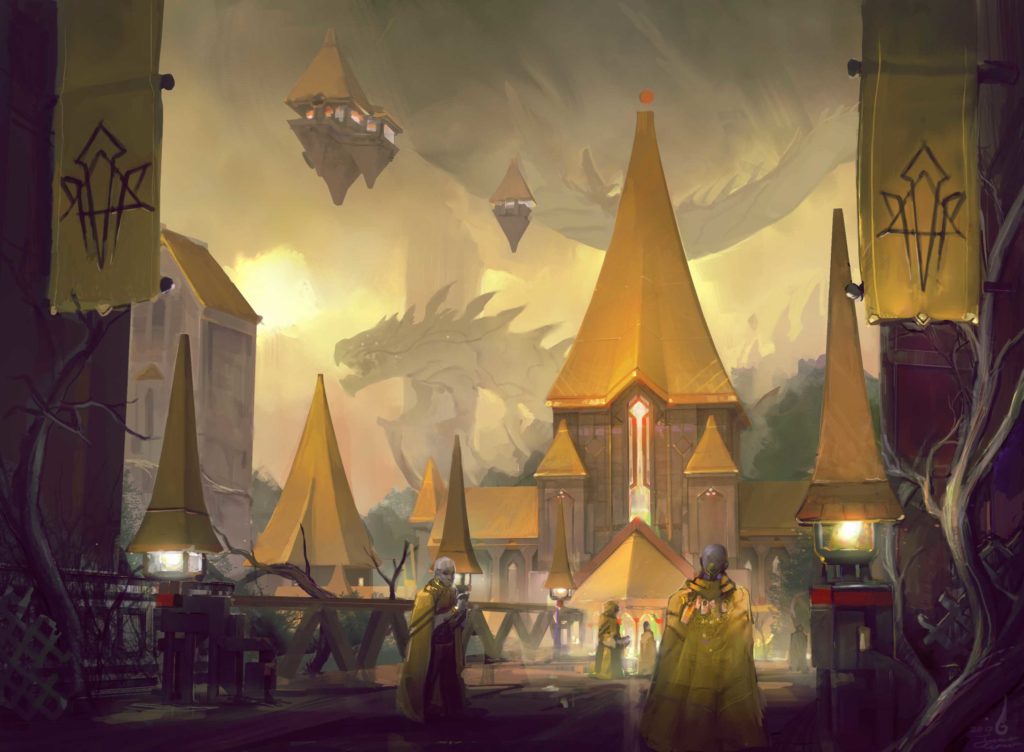
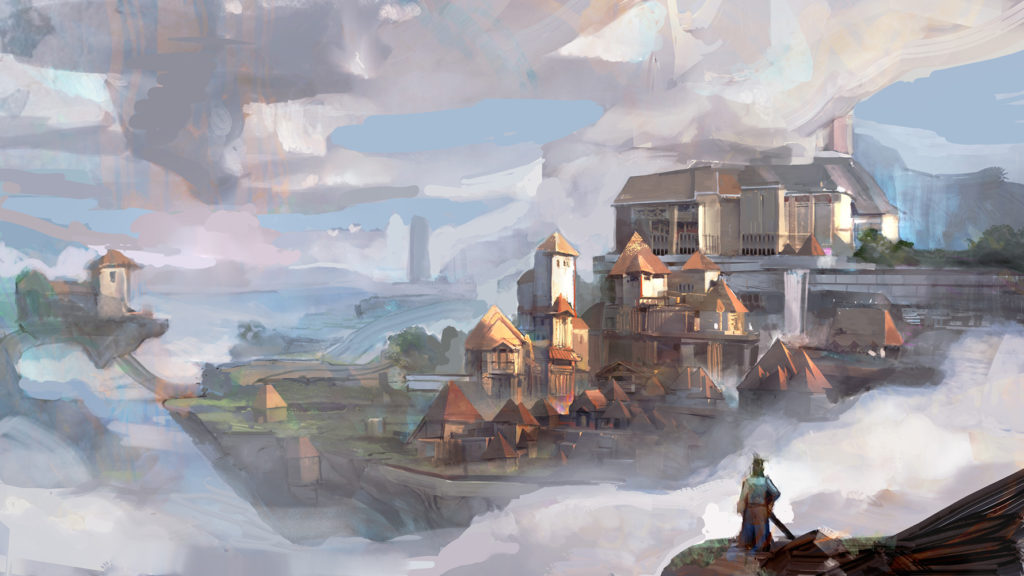
ENG | Let’s talk about colour and its importance in the game. Why did you use this colour range and what role does it play during the game?
Tabula was big on finding a pallet for the game as a whole which is an amazing idea. We kept it pretty tight in the previous game Mysthea but I got to branch out from the set colour range that represented the factions in Volfyirion. Often the rules I would set are keeping the atmosphere misty muted and natural but collecting tangles of high saturated colours blooming out around focal areas or crystals. This would give it the mysterious vibe we want but also make it colourful and beautiful.
ESP | Hablemos del color y su importancia en el juego. ¿Por qué usaste esta gama de colores y qué papel juega durante el juego?
Tabula se empeñó en encontrar una paleta para el juego en general, lo cual es una idea increíble. La mantuvimos bastante ajustada en el juego anterior, Mysthea, pero pude salirme de la gama de colores establecida que representaba a las facciones en Volfyirion. A menudo, las reglas que establecía eran mantener la atmósfera nebulosa y natural, pero recoger marañas de colores muy saturados que florecieran alrededor de las áreas focales o los cristales. Esto le daría el ambiente misterioso que queremos, pero también lo haría colorido y hermoso.
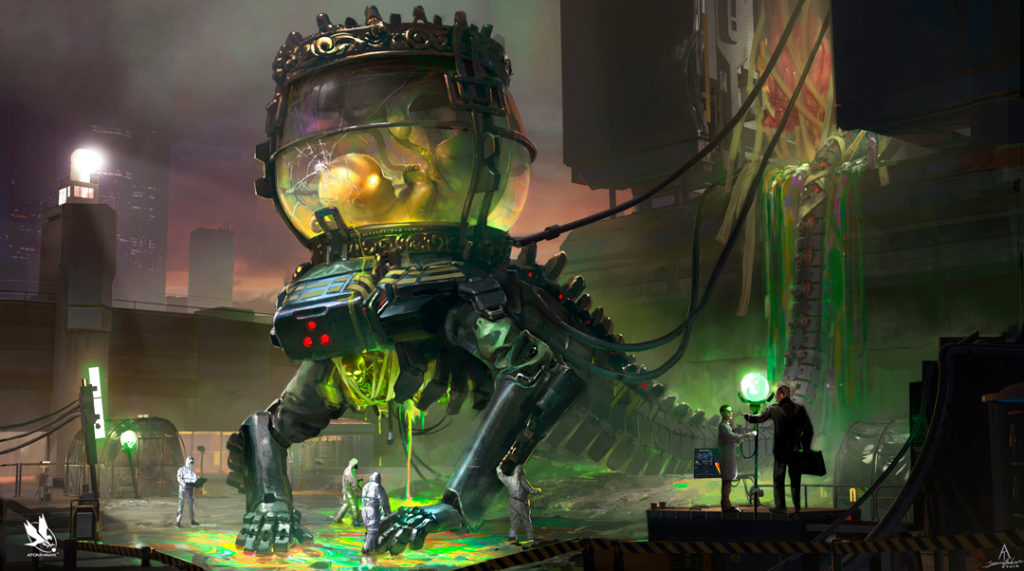
ENG | Finally, do you have any new or upcoming project you want (or can) tell us about?
I mostly have my own two world building projects going on, a world where thread is alive and makes bodies for itself out of found objects. This is inspired by the Greek myth about the sisters of fate cutting the thread of line when people die. The other is a sci-fi world powered by ancient objects and sap from ancient trees. I call that one Relicpunk.
ESP | Finalmente, ¿tiene algún proyecto nuevo o próximo que quiera (o pueda) contarnos?
Tengo dos proyectos de construcción de mundos en marcha, un mundo en el que el hilo da vida y hace que los cuerpos se construyan por sí mismos a partir de objetos encontrados. Está inspirado en el mito griego sobre las hermanas del destino que cortaban el hilo cuando la gente moría. El otro es un mundo de ciencia ficción alimentado por objetos antiguos y savia de árboles antiguos. Lo llamo Relicpunk.
Muchas gracias Travis 😉
(Todas las imágenes cedidas por Travis Anderson)

